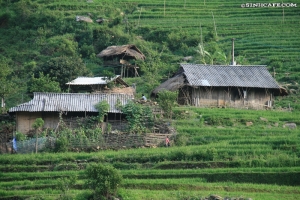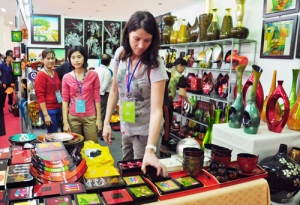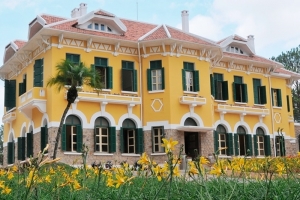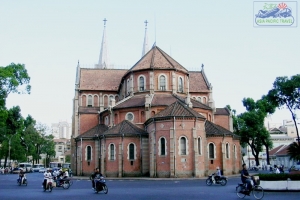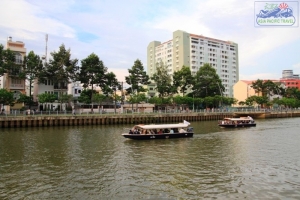"CHAOS"
“HANOI PROMENADE” BY MARTIN RAMA, HAS RECENTLY BEEN PUBLISHED IN VIETNAMESE AND THE ENGLISH VERSION IS ON ITS WAY. “THE GUIDE” US PLEASED TO PUBLISH AN EXCERPT : THE CHAPTER ENTITLED “CHAOS”
For most foreign visitors, the first image of Hanoi is one of chaos, absolute chaos. Rivers of motorbikes thunder through its streets (sometimes, through its sidewalk) paying little attention to traffic lights and other niceties of road safely. Those motorbikes may be modest in size and in engine power, but they look unstoppable nonetheless. Even their names (Angel, Magic…) evoke a detachment from the constraints of manmade rules, if not an imminent trip to heaven. The aspiration that goes with saying “I have a Dream” is clearly not about changing the world, but about running over it. Perhaps this is what the constructors of popular motorbike model had in mind when they aptly named it…Attila !

“The first image of Hanoi is one of chaos, absolute chaos”
The sidewalks themselves do not look more reassuring. Apart from serving as improvised parking lots for legions of motorbikes and cars, they host all sorts of activities which are typically held indoors in other latitudes. Cooking and eating above all. Amids the exhaust fumes, the dust and the dirt, it’s difficult to believe that any of the food stalls would pass a basic hygiene test. The cleaning of dishes, with the same bucket of water serving for hundreds of bowls and glasses, could make the eating experience even more intimidating, at least to foreigners. And that without mentioning the bystanders who only meters away spend hours meticulously removing lice from each other’s heads.

Stalls on sidewalk
Construction on both side of the street is usually as messy as the street itself. The city’architecture heritage, which had survived two wars and a bombing campaign without irreversible damage, is under siege from uncontrolled market forces. Poverty has resulted in myriads of small living quarters of terrible quality piling up over colonial buildings and former gardens. At times, these nondescript volume of plastic, plywood and tin look simply look like vertical garbage dumps. Prosperity did not necessarily arrange matters, as traditional markets and colonial villas are now being demolished to make room for totally insipid buildings.
Well, this is the impression when one actually managers to see the buildings. More often than not, whatever there is on both sides of street id hidden behind layers of strident nylon billboards and an impossible cobweb of electricity and telephone wires. It even takes some time for the eye to distinguish, among the maze, the rusty loudspeakers from which a seemingly endless stream of squeaks and screeches pours on mornings and evenings. An inheritance from the war period, this rudimentary communication system hammers Hanoians twice a day with propaganda and public announcements that become totally unintelligible when mixed with the cacophony of rush hours.

Hanoi Opera House – A Friend colonial construction
However, most foreign visitors soon realize that this chaos is actually governed by subtle, not explicit but widely shared rules. And once those rules are understood, making sense of it all becomes easy.
Yes, traffic is a mess. But it genera;ly flows like a river, smoothly going around obstacles rather than hitting them. A pedestrian who wants to cross the street only needs to enter into the stream in a slow and predictable manner. Motorbike drivers will then marginally adjust their course and pass centimeters away on either side. The effect is even more striking an intersections, where armadas of motorbikes cross through each other without an accident, their timing as perflect as in Vienna’s baroque horse ballets. Watching Hanoi’s spontaneous traffic choreography, one can only marvel at the analytical capacity of motorbike drivers, who are constantly assessing multiple trajectories and in no time identifying a collision-free path through them (while texting message with their mobile phones, mind you…)
It does not take long to realize that the food one can eat in sidewalk food stalls is as good as in the most sophisticated restaurant, if not better. Hygeine conditions may not be ideal, but the ingredients are usually so fresh that it does not really matter. And while surroundings may be messy, they are a fascinating window on the everyday life of many ordinary Hanoians who prefer sidewalks to their crowded interiors. Peddlers do their jobs, mothers feed their children, men play Chinese chess, the elderly wander in their pijamas…And where else other than in Hanoi’s sidewalks can one see an old gentleman with a traditional goatee lovingly grooming his just bathed poodle with a pink hairdryer ?

Peddler in Hanoi
As for the accumulation of crappy living quarters, it has actually save hundreds of magnificent buildings from being demolished. Some cononial villas are so well wrapped up in new dwellings and improvised shops that it is almost impossible to see them from the street. Before any investor can buy the property rights of all the families and businesses around them one can hope that Hanoi will have adopted stronger measures to protect its architectural heritage. In the meantime, it quickly becomes a stimulating exercise to mentally “peel” layer after layer of plastic, plywood and tin to reconstruct the original shapes and proportions of the villas buried underneath.
True, many sidewalks in Hanoi look as if they had been bombared. But this ia due to the ongoing effort by the local government to put all wires underground. Many cities in the industrial world still procrastinated about doing the same, on the excuse that could be unaffordable. Much poorer Hanoi has no hestitation, and the effort is bound to make the city look even more beautiful over time.

A view of Ha Noi by night
What will happen to the rusty loudspeakers as wires go under and poles are removed is still unclear. But there is one noise that is able to offset their stream of squeaks and sreeches, and that is the blaring singing of millions of cicadas in the evening. And on some peaceful dawns, when downtown roosters have not yet stopped crowing, the loudspeaker system also seems compelled to show restraint. In lieu of the endless propaganda and public announcements, on those happy mornings it just delivers a pretty song for the city to gently wake up.
The Guide


















